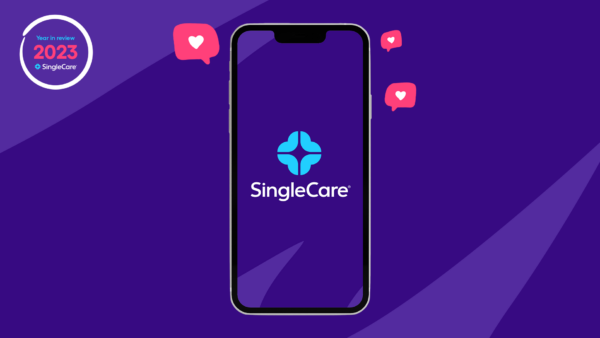“You have lupus,” the doctor said. I sat stunned that day in my rheumatologist’s office. I knew nothing about the disease. Would my symptoms ever go away? Is there a cure? I didn’t know the first thing about living with lupus—or how to treat my pain.
The only thing I knew was that my symptoms had affected every bit of my life. I couldn’t walk up the two stairs to my front door without getting completely winded. My bones ached to no end. The fatigue was so bad that I passed up a fancy dinner out because the thought of chewing sounded like too much work.
But after my diagnosis I had to learn not only what lupus was, but how to manage living with it.
What is lupus?
Lupus is a chronic autoimmune disease where the immune system, which normally fights infection, fights the body’s healthy tissues instead. Lupus can affect any part of the body, causing pain and inflammation. So, what does living with lupus feel like? Common lupus symptoms include:
- Extreme fatigue
- Pain or swelling in the joints
- Headaches
- Low fevers
- Sensitivity to sunlight
- Eye problems
How is lupus diagnosed?
Diagnosing lupus is often a difficult and drawn-out process—taking months to years to complete. Because there is no singular test to diagnose the disease, a healthcare provider will take your history, ask about symptoms, and conduct a variety of lab tests. Sometimes your provider may even refer you to an eye specialist as part of the diagnostic work-up. Because the diagnosis can be confounding, you may need to see a rheumatologist, a specialist who has received extra training in the diagnosis and management of musculoskeletal disease and systemic autoimmune conditions. If enough pieces of the puzzle indicate lupus, you may receive a diagnosis.
I had symptoms, but it wasn’t until several blood tests came back that I received my diagnosis. Still, I was in shock. Lupus was not on my radar—and I am not alone in being caught off guard by my disease.
“It is definitely normal to be surprised by a diagnosis of lupus,” says Neda Yazdi, MD, a rheumatologist in San Diego, California. “Many people have heard of it but are unsure what it is.”
Who is most at risk for lupus?
Lupus may affect as many as 1.5 million Americans, but it is significantly more common in women ages 15 to 44 years—who make up 9 out of 10 new diagnoses overall. It also has the highest prevalence among women of color including African-American and Hispanic women. There are different types of lupus, including some variants that affect newborns and children.
Lupus treatment
As I sat there that day in the doctor’s office, the only thing I could think to ask was, “Should I change my diet?” My healthcare provider noted that there was some evidence that lifestyle changes, such as an anti-inflammatory diet, might make a difference, but a prescription is what would really help.
RELATED: Lupus treatments and medications
Medication
I was prescribed hydroxychloroquine. “[Plaquenil] (hydroxychloroquine) is a wonderful medication that we use very commonly for lupus patients,” Dr. Yadzi says. “It not only helps with the joints and the skin, but it also helps to decrease any organ damage such as with the kidneys.”
For me, there was one drawback: It could take weeks before I felt a difference. I picked up my prescription that night and within a month, I began to feel better. Yet there was a nagging symptom. I still battled fatigue. That’s when I was prescribed Provigil (modafinil), a stimulant medication that is used for excessive daytime sleepiness. On my first use, I felt like superwoman. I finally had the energy to meet my writing deadlines. I could fold my clothes and put away the dishes. It was a helpful medication for me, but it is really important to discuss its use with all of your healthcare providers since it can interfere with medications including cyclosporine, combined hormonal contraception (the pill, patch, or ring), benzodiazepines, and some anti-seizure medications.
This combination worked for me, but lupus affects different people differently. Other medications that treat this condition include:
- NSAIDS, like Advil (ibuprofen)
- Other antimalarials, like Aralen (chloroquine)
- Immunosuppressants, like Trexall (methotrexate) and Imuran (azathioprine)
- Monoclonal antibodies, like Benlysta
- Corticosteroids
RELATED: What is Benlysta?
Physical therapy
At a follow-up appointment, I mentioned that my pain levels were down, but that I still didn’t feel like myself. I wanted to swim, walk, go to spin class, and do yoga like I used to. And for that, I was prescribed physical therapy (PT).
I’d been through PT before for a torn meniscus and a herniated disc. I expected therapy to help, that I’d be prescribed a regimen of exercises to fix me. What I received instead was a lesson in how to scale back my workouts to work with the lupus.
This was hard for me. I was used to a “no pain, no gain” approach to fitness—I didn’t know how to slow down or listen to my body and give it the rest it needed. But I re-learned how to exercise in a way that would restore my strength and cardio fitness, but not deplete me, and I started to feel better.
Dealing with lupus flares
At that point, I began to feel like myself again. But what I didn’t know was that while the hydroxychloroquine was helping my body fight the lupus, I could still experience flares—an exacerbation of symptoms.
It was summer time, and I was spending a lot of time in the sun, by the beach, and staying active—leading a normal Los Angeles life. What I know now is that that was a bad choice.
“The UVA and UVB rays from the sun can trigger a lupus flare,” explains Magdalena Cadet, MD, a NYC-based clinical rheumatologist. “A rash on the face or body may develop minutes, days, and even up to a week after sun exposure.”
I had gotten the rashes and my fatigue increased, but I ignored these signs, not understanding what was happening to my body.
“Cell damage (DNA damage) can occur with ultraviolet radiation and normally the dead cells are cleared in a healthy individual,” Dr. Cadet explains. “In lupus patients, there is a reduction in the speed of clearance of these damaged cells triggering the immune response.”
For me, being out in the sun caused a lupus flare. Other common triggers include:
- Stress
- Infection
- Doing too much
- Being run down
- Overheating
- Alcohol or drug use
When the summer ended, the excruciating pain in my bones was back. The fatigue was full blown. I scaled back on exercise, avoided the sun, and rested more, but it didn’t help.
That’s when I was given a short course of Medrol (methylprednisolone), a steroid. I took it for a week and eventually began to return to what I call my “lupus normal.”
Living with lupus
My “lupus normal” looks different from the normal I used to know before diagnosis. I now have to constantly monitor myself. It also means that I appreciate every day I can get up and go.
Sometimes a dose of Tylenol (acetaminophen) will help with the pain, but sometimes it means completely avoiding the sun and stopping most physical activity for a week or longer. Your provider may recommend or prescribe a non-steroidal anti-inflammatory drug (NSAID) like ibuprofen or naproxen, which can treat both pain and inflammation. However, because NSAIDs can impact kidney function, it is important you check with your provider before taking these medications.
To live your best life with lupus, you will want to receive regular medical care with both your primary care provider and your rheumatologist. Together, you should work out a plan for care, which may include checking your eyes, kidney function, blood counts, routine cancer screenings, and keeping all vaccinations up to date. It is also really important that women of child-bearing age discuss pregnancy and contraception use with their providers since both of these factors can have a significant impact on their health.
My “lupus normal” is a normal I’m grateful for because it’s taught me to slow down, pay attention to my body, and say no to the things that will drain me both mentally and physically—and those are habits that are useful, chronic conditions or not.











